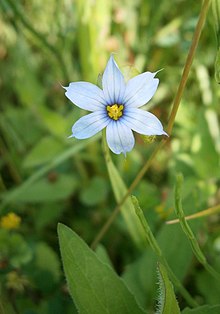Sisyrinchium
| Sisyrinchium | |
|---|---|

| |
| Sisyrinchium bermudiana L. (type species) | |
| Scientific classification | |
| Kingdom: | Plantae |
| Clade: | Tracheophytes |
| Clade: | Angiosperms |
| Clade: | Monocots |
| Order: | Asparagales |
| Family: | Iridaceae |
| Subfamily: | Iridoideae |
| Tribe: | Sisyrinchieae |
| Genus: | Sisyrinchium L. |
| Species | |
| Synonyms[1] | |
| |
Sisyrinchium is a large genus of annual to perennial flowering plants in the family Iridaceae. Native to the New World, the species are known as blue-eyed grasses. Although they are not true grasses (Poaceae), they are monocots.[2]
Several species in the eastern United States are threatened or endangered. This may be due to niche species emerging from their unique tendency toward rapid speciation which helps them adapt to specialized arenic habitats.[3]
Description



These are not true grasses, but many species have the general appearance of grasses, as they are low-growing plants with long, thin leaves. They often grow on grasslands. Many species resemble irises, to which they are more closely related. Most species grow as perennial plants, from a rhizome, though some are short-lived (e.g. Sisyrinchium striatum), and some are annuals (e.g. Sisyrinchium iridifolium).
The flowers are relatively simple and often grow in clusters.
Many species, particularly the South American ones, are not blue, despite the common name. The genus includes species with blue, white, yellow, and purple petals, often with a contrasting centre. Of the species in the United States, the Western Blue-eyed Grass (Sisyrinchium bellum) is sometimes found with white flowers, while the California Golden-eyed Grass (Sisyrinchium californicum) has yellow flowers.
Taxonomy
The genus was named by Carl Linnaeus in 1753, based on the species Sisyrinchium bermudiana (commonly called Bermudiana). The taxonomy of this genus is rather perplexing and confusing,[to whom?] as several of these species, such as Sisyrinchium angustifolium, form complexes with many variants named as species. More genetic research and cladistic analysis need to be performed to sort out the relationships between the species. Some species, notably Sisyrinchium douglasii, have been transferred to the separate genus Olsynium.
The greatest diversity for the genus is found in South America.[4]
Approximately one third of the species in the genus have oil producing hairs called elaiophores to attract oil-bees. Nearly all these species are native to South America.[4]
Etymology
Sisyrinchíon is the Greek word, recorded by Pliny and Theophrastus, for the Barbary nut iris (Iris or Moraea sisyrinchium), and refers to the way the corm tunics resemble a shaggy goat's-hair coat, sisýra.[5] Authors as early as 1666[6] give the dubious etymology of Latin sūs "pig" and Greek rhynchos "nose", referring to pigs grubbing the roots. As Goldblatt and Manning explain, "the reason for applying the name to a genus of New World Iridaceae was apparently arbitrary."[7]
Selected species
There are up to 200 species,[8] including:
|
Gallery
- Prairie blue-eyed grass (Sisyrinchium campestre)
- Strict blue-eyed grass (Sisyrinchium montanum var. montanum)
- Needletip blue-eyed grass (Sisyrinchium mucronatum)
- Coastalplain blue-eyed grass (Sisyrinchium fuscatum)
References
- ^ Kew World Checklist of Selected Plant Families
- ^ "Sisyrinchium angustifolium".
- ^ TWO NEW SPECIES OF SISYRINCHIUM (IRIDACEAE) FROM SOUTH-CENTRAL UNITED STATES (PDF)
- ^ a b Chauveau, Olivier; Eggers, Lilian; Raquin, Christian; Silvério, Adriano; Brown, Spencer; Couloux, Arnaud; Cruaud, Corine; Kaltchuk-Santos, Eliane; Yockteng, Roxana; Souza-Chies, Tatiana T.; Nadot, Sophie (2011). "Evolution of oil-producing trichomes in Sisyrinchium (Iridaceae): insights from the first comprehensive phylogenetic analysis of the genus". Annals of Botany. 107 (8): 1287–1312. doi:10.1093/aob/mcr080. ISSN 0305-7364. JSTOR 43578242. PMC 3101146. PMID 21527419.
- ^ σισυριγχίον, σισύρα. Liddell, Henry George; Scott, Robert; A Greek–English Lexicon at the Perseus Project
- ^ Ambrosini, Giacinto. 1666. Phytologiae
- ^ Manning, John; Goldblatt, Peter (2008). The Iris Family: Natural History & Classification. Portland, Oregon: Timber Press. pp. 221–25. ISBN 978-0-88192-897-6.
- ^ Search for "Sisyrinchium", World Checklist of Selected Plant Families, Royal Botanic Gardens, Kew, retrieved 2012-09-22
- Rudall, P. J., A. Y. Kenton, and T. J. Lawrence. 1986 - An anatomical and chromosomal investigation of Sisyrinchium and allied genera. Bot. Gaz. 147: 466–477 Ajilvsgi, Geyata. 1984 - Wildflowers of Texas. Library of Congress: 84-50025




